D103 Golgi and Endo/Exocytosis (ALS 12, VIdeos 21 and 22)
1/36
There's no tags or description
Looks like no tags are added yet.
Name | Mastery | Learn | Test | Matching | Spaced |
|---|
No study sessions yet.
37 Terms
where does the golgi secrete to
sorting depends on the sorting signal
cell exterior (secretion)
plasma membrane
lysosme
other parts of the endomembrane system
steps of protein trafficking
returned to the ER
retained in the Golgi apparatus
delivered to the endolysosomal system
delivered directly to the plasma membrane
constitutive secretion
default path: proteins in plasma membrane and ECM, lipids, etc
newly synthesized soluble proteins packed in new plasma membrane lipis and protein for unregulated membrane fusion
delivers the soluble protein to the extracellular space

regulatory secretion
stored, wait for signal stimulation (ex - hormones, digestive enzymes)
golgi releases secretory vesicle storing secretory proteins
regulated membrane fusion is mediated via an intracellular signaling pathway (signal = hormone or neurotransmitter)
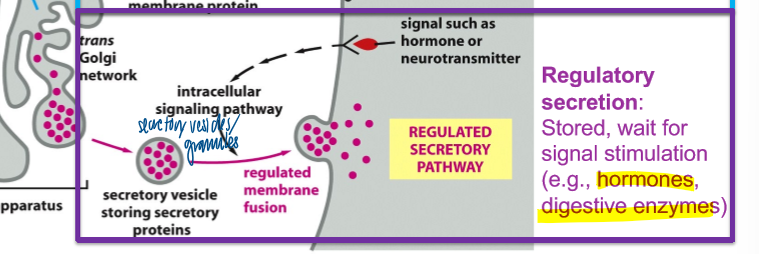
complications of constitutive transport
unclear how the cargo is sorted into these carriers
sorting signals not well defined (is traenport to the cell surface by default so that no sorting signal is necessary?)
difference to other transport: there is not a single dominant transport mech
what does regulated secretion depend on
the release of cargo from storage granules
stores hormones, mucus, and neurotransmitters
sorting signal: proteins selectively aggregate with one another in TGN
unknown sorting machinery
exocytosis is triggered by a signal (usually chemical, like Ca2+)
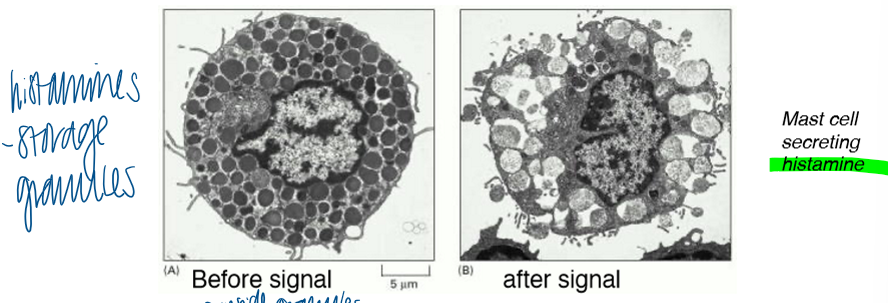
lysosome
major degradation organelle
diverse in shape and size
fulfills variety of digestive functions
very low pH due to ATP-driven proton pump
pH an proteins in the lysosome
optimal pH = 5
hydrolases that degrade other molecules
cargo that is targeted for destruction
digestive functions of lysosome
breakdown of intra/extracellular material
destruction of phgocytosed microorgs
breakdown products serve a nutrient for the cell
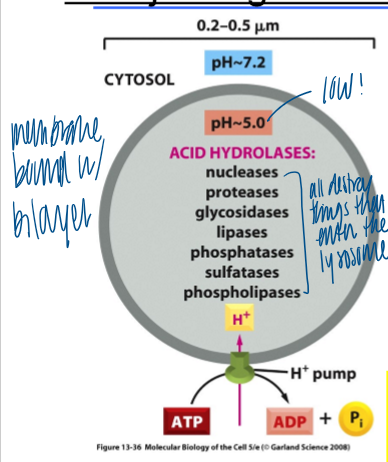
niemann-pick disease
lysosomal storage disease
defects in the breakdown of lipids/cholesterol in the lysosome, leading to damage of brain, liver, and lungs
type A
acid sphingomyelinase is affected (SM → Cer)
SM accumulates in cells, leading to enlarged spleen and liver; also characteritic red cherry spot in the eye
death in early childhood
how are proteins transported to the lysosome
TGN → endosome (early, becoming late) → lysosome
Step #1: mediated by clathrin-coated vesicles; transport cargo
Step #2: maturation process where late endosome fuses with lysosome
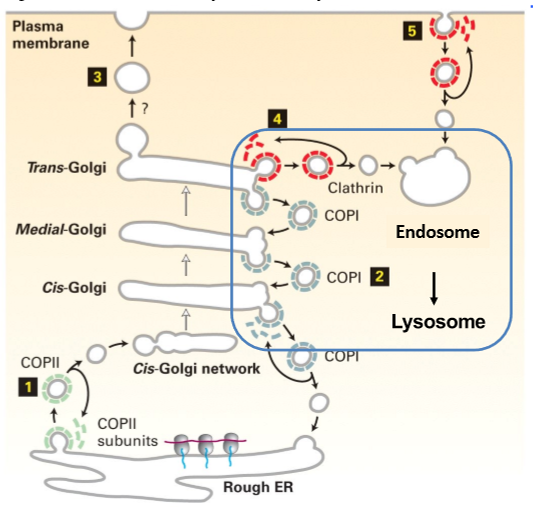
how are proteins transported from the tgn to the endosome
sorting signal: M6P
a phosphorylated sugar that is part of the n-glycan (NOT a domain that is a part of the protein)
generated in cis-golgi
receptor: M6P receptor
vesicle coat: clathrin
2 layers of the coat (like COPII)
inner layer: adaptors → interact with the cargo
outer layer: clathrin → membrane curvature
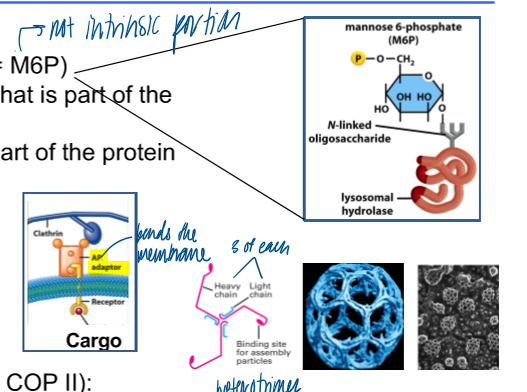
what regulates cargo-cargo receptor intearction in endosomal transport
regulated by pH
determines the interaction between M6P and its receptor
pH in TGN = 6.5 - 6.7 (M6P binds to receptor)
pH in endosome = 6 (M6P no longer binds the receptor and dissociates)
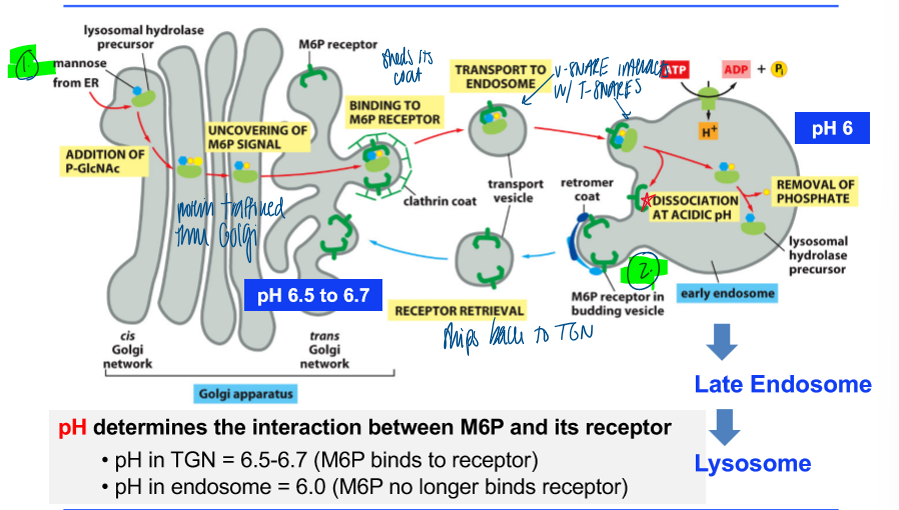
overview of TGN to PM
constitutive transport: mech not fully understood; multiple pathways
regulated transport: aggregation of cargo to sort it into vesicle; fusion with PM in response to signal
TGM to endosome transport
M6P serves as sorting signal
not directly encoded by the primary AA of a protein
requires a protein to be N-glycosylated in the ER; glycan is then moified to make M6P in the cis-Golgi → recognized by M6P receptor in TGN
M6P receptor bidnds to adaptor that in turn interact with clathrin coat
receptor-cargo interaction is regulated by pH → low pH of endosome promotes dissociation of cargo from receptor
M6P-R is recycled back to the TGN, buding of these retromer-coated vesicles is facilitated by the ER that “wraps” around the endosome
lysosome overview
membrane bound compartment that functions in degradation of proteins and also organelles
pH is lower (5) due to ATP-driven proton pump
contains many degradative enzymes
proteins in this organelle
function in the degradation of proteins (various hydrolases)
proteins that are delivered to be degraded → no return
phagocytosis
cellular eating of large particles (microorganisms, senescnet and apoptotic cells)
actin-mediated process
goal: delivery to the lysosome so that engulfed material can be destroyed
pinocytosis
fluid phase endocytosis
liquid and what is dissolved in it → non-specific
receptor-mediated endocytosis
goals:
obtain nutrients (iron, cholesterol)
remove potentially harmful molecules (neurotransmitters considered harmful bc signal may be lasting too long)
remove signaling or adhesion molecules from the cell surface (allow cell to move forward)
mechanism: specific cargo selection via sorting signal
endocytic pathways that internalize specific cargo
clathrin-dependent (most well-known)
dynamin pinches off the vesicle; clathrin-coat falls off and fuses with the early endosome
caveolin-dependent
forms around the vesicle and goes to the early endosome
clathrin- and caveolin-independent internalization
vesicular or tubular → early endosome
uptake of LDL cholesterol
example of receptor-mediated endocytosis
LDL receptor has specific endocytic sorting signal
separation of cargo and receptor due to low pH in endosome
activated small GTPase generates membrane domain with specific lipid composition
AP2 adaptor is recruited to this site
AP2 recruts cargo receptor, bound to cargo
AP2 also recruits clathrin coat → membrane curvature
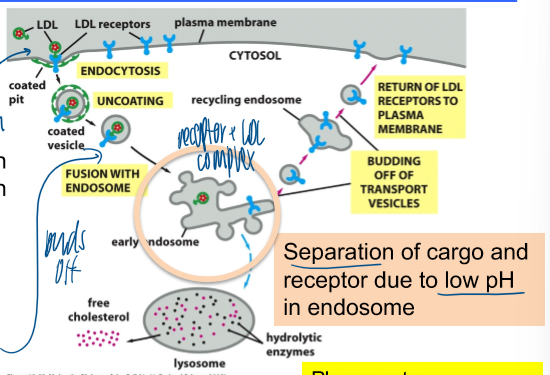
AP1
tetrameric complex that moves from TGN → endosome
AP2
tetrameric complex that moves from PM → endosome
comparison of the role of small GTPases in vesicle formation
COPII/I: Sar1/ Arf1 → coat (inner layer) → cargo (coat recrutis cargo)
clathrin: Arf1 → changes lipid environment in membrane → AP adaptor (=inner coat layer) → cargo, also bind to clathrin coat
COP does not change the lipid environment
LDL and familial hypercholesterolemia (FH)
cholesterol is circulating in blood as lipoprotein particle (VLDL, LDL, HDL)
LDL cholesterol is the “bad choleterol” because high levels of LDL promote plaque disposition → atherosclerosis and heart attack
high LDL = high plaque = high MI rates
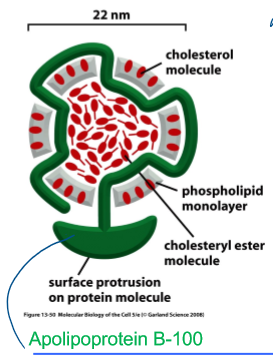
LDL uptake in FH pts
LDL uptake is defective
sorting signal in LDL receptor
receptor cannot be recruited into vesicel
LDL uptake is defective
AP2 adaptor
sorting signal cannot be recognized
ldl uptake is defective
normal LDL uptake
short cytoplasmic tail of LDL receptor interacts with the AP2 adaptor
necessary and sufficient for uptake of LDL-R and its cargo LDL-cholesterol
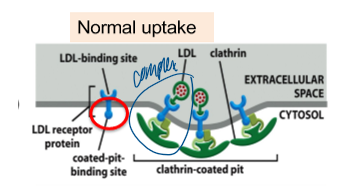
fate of endocytosed receptors
determined by their sorting signals
LDL-R: recycled to cell surface
EGF-R (growth factor receptor): down regulation thru degradation by the lysosome
early endosome mature into late endosomes
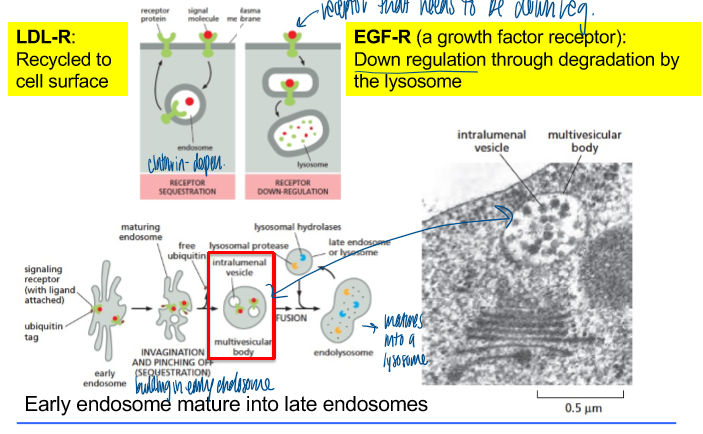
how are proteins sorted into the late endosome
sorting signal: mono-ubiquitin (polyubiquitin targets protein for degradation)
receptor to detect the signal: ESCRT-0
vesicle coat: none, but ECRT complexes help with the budding of the vesicle
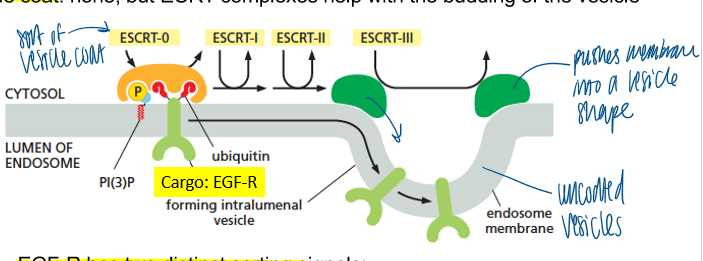
EGF-R sorting signals
clathrin-mediated endocytosis
budding into the late endosome
what does the fate of tm protein targeted to lysosome depend on
sorting signal
TM hydrolases: bisynthetic pathway; lack mono-ubiquitin sorting signal for budding into the late endosome → lysosome
TM proteins to be degraded: degradative pathway; contain the mono-ubiquitin sorting signals for budding into the late endosome → PM
autophagy
the lysosome can also degrade cytosolic proteins and organelles
goal:
acquisition of nutrients: self-eating
removal of non-functional organelles protein aggregates; microbes
cellular mechanism fro degradation
steps:
formation of crescent-shape cup (depends on Atg9)
closure of membrane cup (autophagosome)
autophagosome fuses with lysosome
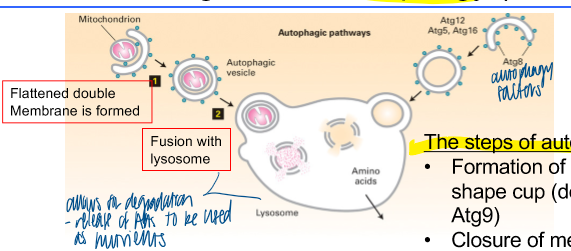
uptake of material from the environment
phagocytosis: actin-mediated
endocytosis: pinocytosis/ receptor-mediated endocytosis
receptor-mediated endocytosis
ex: LDL chol → receptors → uptake
depends on a specific sorting signals in cytosolic domain of the receptor (TM protein)
interact via adaptor protein (AP2, or monomeric adaptor) with clathrin
degradation of membrane proteins by the lysosome
multivesicular bodies → vesicles that bud into the endosome
sorting signal: mono-ubiquitin, machinery (receptor/coat): ESCRT complexes
exocytic and endocytic pathways intersect at the endosome
exocytic route: transport of hydrolases that function in the lysosome
endocytic route: cargo to be degraded
degradation of cytosolic material
old organelles; autophagy